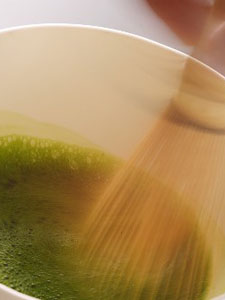Between the Leaves July 2008
I've been reading the TeaChat forums for a while, and lately it seems that everyones going crazy over "shincha". I thought Japan just produced sencha and matcha. What is this new tea, and why is it so great?
Oh, the long-awaited and much adored shincha season. Every year, you can almost hear the excitement rising on the forum boards when the calendar clicks over to May, and it stays buzzing clear through June. To say some of our users go crazy over it might just be an understatement: It's practically their raison d'etre.

If you just look at a few of the posts over at TeaChat, it is very easy to get the impression that shincha is a whole new type of Japanese wundertea. In reality, though, it's just sencha. However, it happens to be a sencha that was plucked from the very first harvest of the year (ichibanchain Japanese) and then immediately packaged and shipped for your brewing pleasure. It is the immediate shipment that makes this first Japanese green tea of the year "shincha" or "new tea". If that same tea is put into cold storage and sold later in the year, it can no longer be called shincha, but instead must be termed ichiban sencha.
Shincha, then, is the absolute freshest sencha you can taste. The flavor is usually more pronounced and "field fresh" than those plucked in subsequent harvests (nibancha and sanbancha, or the second and third harvests) and some feel that it is also more intense than teas held over from the first harvest. So to many of the TeaChatters, shincha is a taste of spring itself: an experience on par with the first sunny, warm day of the year, and certainly not one to be missed.
Of course, none of the other Japanese teas should be passed up either. While Japan does produce a multitude of senchas (some of the more specialized variations being fukamushi, or deep-steamed, asamushi, or light-steamed, and kabusecha, which is shaded for about two weeks before harvest) and matcha (of which there two primary types: usucha or 'thin' tea, and koicha or 'thick' tea), it also created and continues to produce several other unique teas as well.
One of the more accessible groups is bancha, the "everyday" tea of Japan. It is, however, a fairly loose grouping and has a variety of tastes ranging from sencha grassiness to mellow woodiness. Classically, it was bancha that was either mixed with toasted rice to make genmaicha or roasted over charcoal to make hojicha. Today, however, genmaicha can be made with sencha or even dusted with matcha, and hojicha is now frequently made with kukicha, a tea processed from the stems and twigs of the tea bush.
On the other end of the spectrum from everyday bunch is the special clan: gyokuro and tamaryokucha or guricha. Gyokuro, in particular, is considered one of the highest grades of Japanese tea and its liquor has a distinct green color and soft, mellow sweetness due to an extended shading of about 20 days before its harvest. A special kukicha called karigane can be made from the stems of gyokuro leaves and is also notably sweeter than those made from sencha/bancha plants. Tamaryokucha or guricha (both words loosely meaning 'curly leaf tea') has a similar sweetness to gyokuro, but is a little more tart or fruity. Unlike gyokuro, though, it achieves its sweetness from leaf processing rather than cultivation. In fact, tamaryokucha/guricha is made almost exactly as sencha is, but without the final kneading steps that give sencha its straight, flat shape and classic astringency.
This is neither an exhaustive or detailed listing of all types of Japanese teasand that's a very good thing! A full dissertation of growing regions, plant varieties, and processing variations would probably giveMoby Dick stiff competition in terms of word count. This is, however, a decent introduction to some great 'new teas'. Try them and enjoy!
Join the shincha conversation on TeaChat.com!
